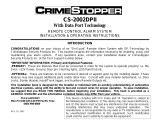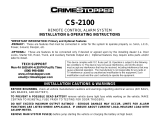Bulldog Security PRO-SERIES 5002 Owner's manual
- Category
- Remote starters
- Type
- Owner's manual
This manual is also suitable for
Bulldog Security PRO-SERIES 5002 is an advanced car security system that offers a wide range of features to protect your vehicle and make your life easier. With its long-range four-button remotes, you can operate the system from a distance, locking and unlocking your doors, opening your trunk, and locating your vehicle in a crowded parking lot. The system also includes a starter immobilizer output, which prevents thieves from starting your vehicle even if they have your keys. Other features include:
- Instant personal panic protection
- Distracted entry
- Valet mode
- Dome light
- Active arming
Bulldog Security PRO-SERIES 5002 is an advanced car security system that offers a wide range of features to protect your vehicle and make your life easier. With its long-range four-button remotes, you can operate the system from a distance, locking and unlocking your doors, opening your trunk, and locating your vehicle in a crowded parking lot. The system also includes a starter immobilizer output, which prevents thieves from starting your vehicle even if they have your keys. Other features include:
- Instant personal panic protection
- Distracted entry
- Valet mode
- Dome light
- Active arming











-
 1
1
-
 2
2
-
 3
3
-
 4
4
-
 5
5
-
 6
6
-
 7
7
-
 8
8
-
 9
9
-
 10
10
-
 11
11
Bulldog Security PRO-SERIES 5002 Owner's manual
- Category
- Remote starters
- Type
- Owner's manual
- This manual is also suitable for
Bulldog Security PRO-SERIES 5002 is an advanced car security system that offers a wide range of features to protect your vehicle and make your life easier. With its long-range four-button remotes, you can operate the system from a distance, locking and unlocking your doors, opening your trunk, and locating your vehicle in a crowded parking lot. The system also includes a starter immobilizer output, which prevents thieves from starting your vehicle even if they have your keys. Other features include:
- Instant personal panic protection
- Distracted entry
- Valet mode
- Dome light
- Active arming
Ask a question and I''ll find the answer in the document
Finding information in a document is now easier with AI
Related papers
-
Bulldog Security Pro-Series 7002 User manual
-
Bulldog Security 1302 Owner's manual
-
Bulldog Security GM-7, GM-6 Owner's manual
-
Bulldog Security 901-902-903-908 User manual
-
Bulldog Security 5002PRO User manual
-
Bulldog Security Deluxe 62 Owner's manual
-
Bulldog Security 1402 User manual
-
Bulldog Security 727 Owner's manual
-
Bulldog Security RS602E User manual
-
Bulldog Security 1001 Owner's manual
Other documents
-
 Crimestopper Security Products Automobile Alarm CS-2001FC User manual
Crimestopper Security Products Automobile Alarm CS-2001FC User manual
-
 Crimestopper Security Products CS-2002DC.II User manual
Crimestopper Security Products CS-2002DC.II User manual
-
 Crimestopper Security Products CS-2002DPII User manual
Crimestopper Security Products CS-2002DPII User manual
-
 Crimestopper Security Products CS-2002DC SERIES III User manual
Crimestopper Security Products CS-2002DC SERIES III User manual
-
 Crimestopper Security Products CS-2002DC SERIES III User manual
Crimestopper Security Products CS-2002DC SERIES III User manual
-
 Crimestopper Security Products CS-2100 User manual
Crimestopper Security Products CS-2100 User manual
-
Audiovox AA-940 User manual
-
Crimestopper Security Products CS-2000.III User manual
-
PAC BHA2002 User manual
-
Viper Responder LE 5701 Installation guide
















